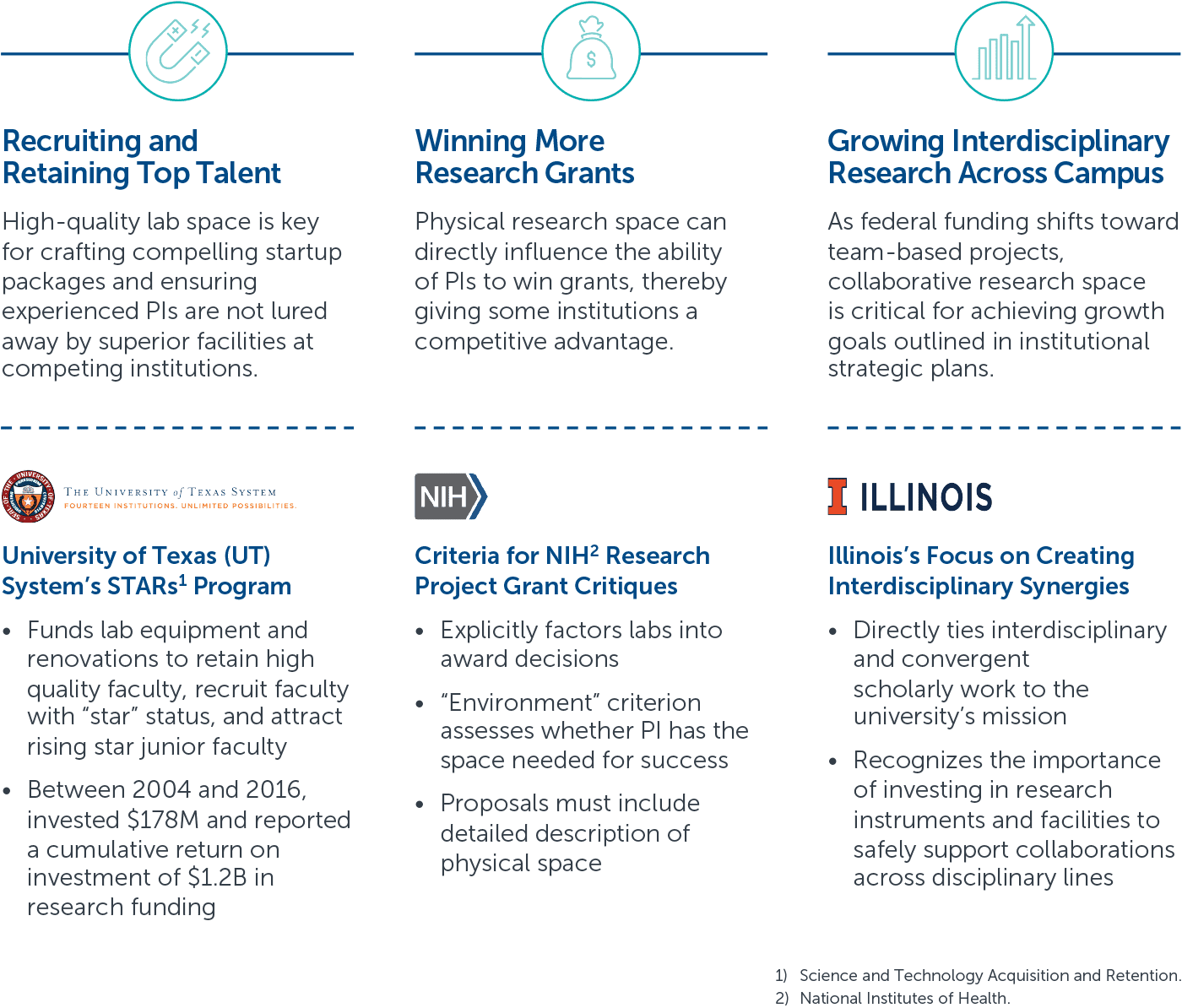Modernize Research Lab Design and Management
Research labs are critical for executing on institutional strategic goals and competing in today’s hypercompetitive environment. But labs are expensive to build and renovate, and decentralized space governance makes it difficult to maximize the value of existing space or streamline inefficient processes. As a result, facilities, research, and academic leaders need to collaborate to develop a more proactive and integrated campus strategy for designing and managing research labs.

Educate campus partners on the value of research labs
Many stakeholders underestimate the importance of lab space for achieving strategic goals, making it difficult for leaders to garner buy-in for policy changes or new investments. Leaders therefore need to explain how labs help institutions attract and retain top faculty talent, win more research funding, and enable interdisciplinary collaboration.


Source: University of Texas System, STARs Program and “UT System invests $30M to recruit nation’s top faculty to ‘Win the Talent War”; National Institutes of Health, “Definitions of Criteria and Considerations for Research Project Grant Critiques”; University of Illinois, Strategic Plan; EAB interviews and analysis.
Formalize the lab setup process for new faculty hires
Institutions often wait to request information about new hire lab needs or initiate lab planning conversations until after recruits have accepted an offer. As a result, most institutions cannot complete renovations before new hires arrive on campus.
In some cases, labs are not finished until more than a year after arrival. This hinders researcher productivity and career advancement. Instead, leaders need to pull forward the lab planning and information gathering process so they can expedite new hire setup.

“The research life of an investigator is about 30 years. Our goal is to have their lab ready when they show up. If they must wait a year for their lab to be ready, we’re reducing their research lifetime by 3%. Meanwhile, their tenure clock is ticking.”
Jim Cowell, Associate Vice President, Facilities
California Institute of Technology
Provide resources and support to expedite renovations
Most campus research labs are severely out of date and in desperate need of upgrades. But renovating labs is expensive and time-consuming. This means many institutions deprioritize lab improvements at the expense of new hire lab setup or student-facing projects. And even when leaders dedicate resources to updating labs, they often lack space to temporarily house PIs during the renovations.
Institutions should therefore provide dedicated funding and swing space for lab renovations so they can improve outdated labs quicker. Learn how to:

Rightsize individual investigator space allocations using productivity metrics
At many research universities, there is a mismatch between PI lab allocations and their actual space needs. In some cases, PIs have more space than their current projects require, and in others, PIs lack sufficient space to conduct their research.
To maximize space efficiency and better align allocations with researcher needs, institutions should establish procedures to optimize initial lab space allocations and fine-tune them over time based on research productivity metrics.


“With shrinking state budgets and challenges winning more federal research funding, we’re having to think about more efficient utilization of the lab space we’ve got. That means recognizing that we don’t always need new buildings to accommodate growth—there are times when someone just needs to give up some underutilized space.”
Joseph Heppert, Vice President for Research & Innovation
Texas Tech University
Hardwire new research space to promote interdisciplinary collaboration
Given federal funding shifts, many institutions want to grow interdisciplinary research on campus. But historically, institutions have not designed research labs with diverse research teams or collaboration in mind. And since interdisciplinary space is typically governed by academic units, central leaders often struggle to incentivize cross-discipline work.
To hardwire interdisciplinary buildings to promote collaboration, institutions should adopt 15 forward-looking design and management principles, which we’ve outlined in our infographic.

Get more tactics to promote collaboration

This resource requires EAB partnership access to view.
Access the roadmap
Learn how you can get access to this resource as well as hands-on support from our experts through Strategic Advisory Services.
Learn More